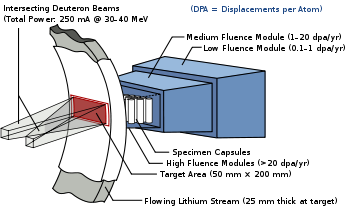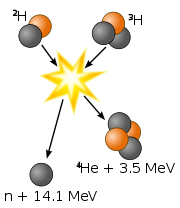
International Fusion Materials Irradiation Facility
Encyclopedia

Fusion power
Fusion power is the power generated by nuclear fusion processes. In fusion reactions two light atomic nuclei fuse together to form a heavier nucleus . In doing so they release a comparatively large amount of energy arising from the binding energy due to the strong nuclear force which is manifested...
. The IFMIF, planned by Japan
Japan
Japan is an island nation in East Asia. Located in the Pacific Ocean, it lies to the east of the Sea of Japan, China, North Korea, South Korea and Russia, stretching from the Sea of Okhotsk in the north to the East China Sea and Taiwan in the south...
, the European Union
European Union
The European Union is an economic and political union of 27 independent member states which are located primarily in Europe. The EU traces its origins from the European Coal and Steel Community and the European Economic Community , formed by six countries in 1958...
, the United States
United States
The United States of America is a federal constitutional republic comprising fifty states and a federal district...
, and Russia
Russia
Russia or , officially known as both Russia and the Russian Federation , is a country in northern Eurasia. It is a federal semi-presidential republic, comprising 83 federal subjects...
, and managed by the International Energy Agency
International Energy Agency
The International Energy Agency is a Paris-based autonomous intergovernmental organization established in the framework of the Organisation for Economic Co-operation and Development in 1974 in the wake of the 1973 oil crisis...
, will use a particle accelerator
Particle accelerator
A particle accelerator is a device that uses electromagnetic fields to propel charged particles to high speeds and to contain them in well-defined beams. An ordinary CRT television set is a simple form of accelerator. There are two basic types: electrostatic and oscillating field accelerators.In...
-based neutron
Neutron
The neutron is a subatomic hadron particle which has the symbol or , no net electric charge and a mass slightly larger than that of a proton. With the exception of hydrogen, nuclei of atoms consist of protons and neutrons, which are therefore collectively referred to as nucleons. The number of...
source to produce a large neutron flux
Neutron flux
The neutron flux is a quantity used in reactor physics corresponding to the total length travelled by all neutrons per unit time and volume . The neutron fluence is defined as the neutron flux integrated over a certain time period....
, in a suitable quantity and time period to test the long-term behavior of materials under conditions similar to those expected at the inner wall of a fusion reactor.
Construction
The IFMIF will consist of two parallel accelerators, each about 50 m long, producing beams of deuteriumDeuterium
Deuterium, also called heavy hydrogen, is one of two stable isotopes of hydrogen. It has a natural abundance in Earth's oceans of about one atom in of hydrogen . Deuterium accounts for approximately 0.0156% of all naturally occurring hydrogen in Earth's oceans, while the most common isotope ...
nuclei. These, on contact with a lithium
Lithium
Lithium is a soft, silver-white metal that belongs to the alkali metal group of chemical elements. It is represented by the symbol Li, and it has the atomic number 3. Under standard conditions it is the lightest metal and the least dense solid element. Like all alkali metals, lithium is highly...
target, will be converted into high-energy neutrons and used to irradiate materials specimens and test components.
Preparation for IFMIF construction is expected to have begun around 2006, although operation testing of materials is not scheduled until roughly 2017. IFMIF is unlikely, therefore, to be useful in the construction of the first-generation ITER
ITER
ITER is an international nuclear fusion research and engineering project, which is currently building the world's largest and most advanced experimental tokamak nuclear fusion reactor at Cadarache in the south of France...
reactor, but will provide important construction information for commercial fusion reactors after ITER, such as DEMO.
Background information

Pressurized water reactor
Pressurized water reactors constitute a large majority of all western nuclear power plants and are one of three types of light water reactor , the other types being boiling water reactors and supercritical water reactors...
s. Each atom in the blanket of a fusion reactor is expected to be hit by a neutron and displaced about a hundred times before the material is replaced. Furthermore the high-energy neutrons will produce hydrogen and helium in various nuclear reactions that tends to form bubbles at grain boundaries and result in swelling, blistering or embrittlement. One also wishes to choose materials whose primary components and impurities do not result in long-lived radioactive wastes. Finally, the mechanical forces and temperatures are large, and there may be frequent cycling of both.
The problem is exacerbated because realistic material tests must expose samples to neutron fluxes of a similar level for a similar length of time as those expected in a fusion power plant. Such a neutron source is nearly as complicated and expensive as a fusion reactor itself would be. Proper materials testing will not be possible in ITER
ITER
ITER is an international nuclear fusion research and engineering project, which is currently building the world's largest and most advanced experimental tokamak nuclear fusion reactor at Cadarache in the south of France...
; the problem is due to be addressed by IFMIF.
The material of the plasma facing components (PFC) is a special problem. The PFC do not have to withstand large mechanical loads, so neutron damage is much less of an issue. They do have to withstand extremely large thermal loads, up to 10 MW/m², which is a difficult but solvable problem. Regardless of the material chosen, the heat flux
Heat flux
Heat flux or thermal flux is the rate of heat energy transfer through a given surface. The SI derived unit of heat rate is joule per second, or watt. Heat flux is the heat rate per unit area. In SI units, heat flux is measured in W/m2]. Heat rate is a scalar quantity, while heat flux is a vectorial...
can only be accommodated without melting if the distance from the front surface to the coolant is not more than a centimeter or two. The primary issue is the interaction with the plasma. One can choose either a low-Z
Atomic number
In chemistry and physics, the atomic number is the number of protons found in the nucleus of an atom and therefore identical to the charge number of the nucleus. It is conventionally represented by the symbol Z. The atomic number uniquely identifies a chemical element...
material, typified by graphite
Graphite
The mineral graphite is one of the allotropes of carbon. It was named by Abraham Gottlob Werner in 1789 from the Ancient Greek γράφω , "to draw/write", for its use in pencils, where it is commonly called lead . Unlike diamond , graphite is an electrical conductor, a semimetal...
although for some purposes beryllium
Beryllium
Beryllium is the chemical element with the symbol Be and atomic number 4. It is a divalent element which occurs naturally only in combination with other elements in minerals. Notable gemstones which contain beryllium include beryl and chrysoberyl...
might be chosen, or a high-Z
Atomic number
In chemistry and physics, the atomic number is the number of protons found in the nucleus of an atom and therefore identical to the charge number of the nucleus. It is conventionally represented by the symbol Z. The atomic number uniquely identifies a chemical element...
material, usually tungsten
Tungsten
Tungsten , also known as wolfram , is a chemical element with the chemical symbol W and atomic number 74.A hard, rare metal under standard conditions when uncombined, tungsten is found naturally on Earth only in chemical compounds. It was identified as a new element in 1781, and first isolated as...
with molybdenum
Molybdenum
Molybdenum , is a Group 6 chemical element with the symbol Mo and atomic number 42. The name is from Neo-Latin Molybdaenum, from Ancient Greek , meaning lead, itself proposed as a loanword from Anatolian Luvian and Lydian languages, since its ores were confused with lead ores...
as a second choice.
Carbon
If graphite is used, the gross erosion rates due to physical and chemical sputteringSputtering
Sputtering is a process whereby atoms are ejected from a solid target material due to bombardment of the target by energetic particles. It is commonly used for thin-film deposition, etching and analytical techniques .-Physics of sputtering:...
would be many meters per year, so one must rely on redeposition of the sputtered material. The location of the redeposition will not exactly coincide with the location of the sputtering, so one is still left with erosion rates that may be prohibitive. An even larger problem is the tritium co-deposited with the redeposited graphite. The tritium inventory in graphite layers and dust in a reactor could quickly build up to many kilograms, representing a waste of resources and a serious radiological hazard in case of an accident. The consensus of the fusion community seems to be that graphite, although a very attractive material for fusion experiments, cannot be the primary PFC material in a commercial reactor.

